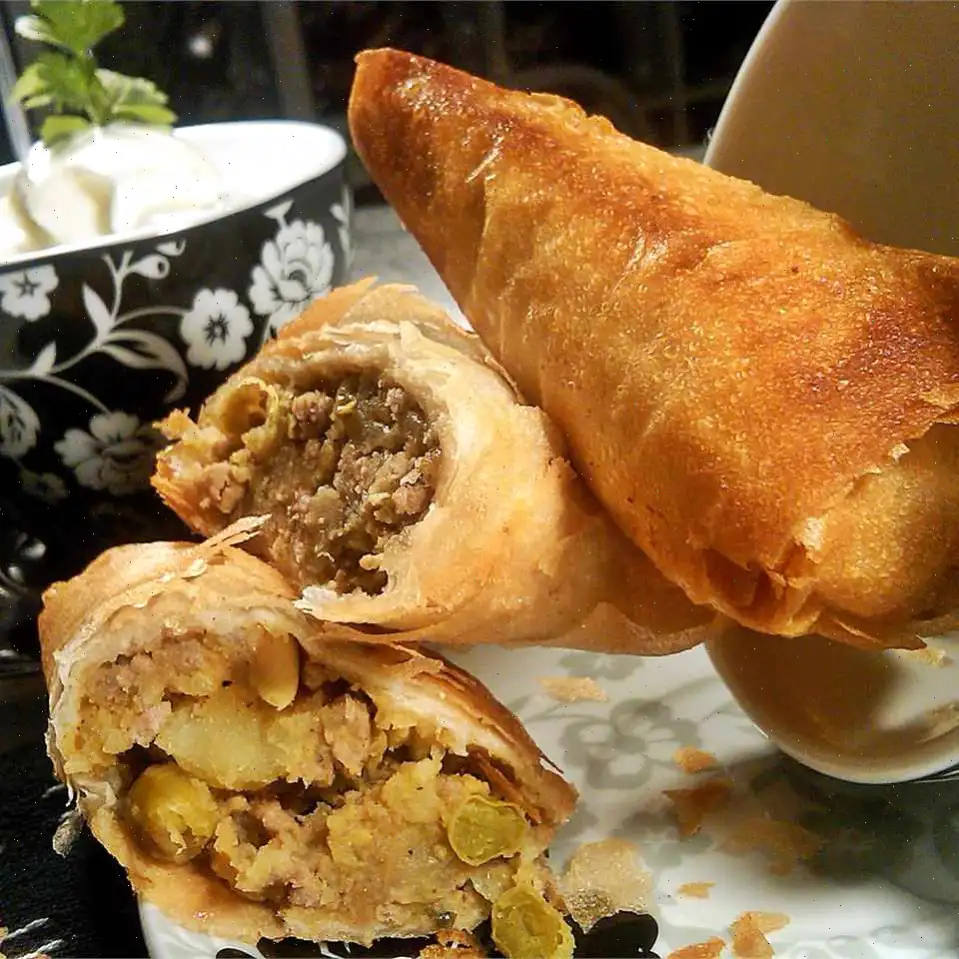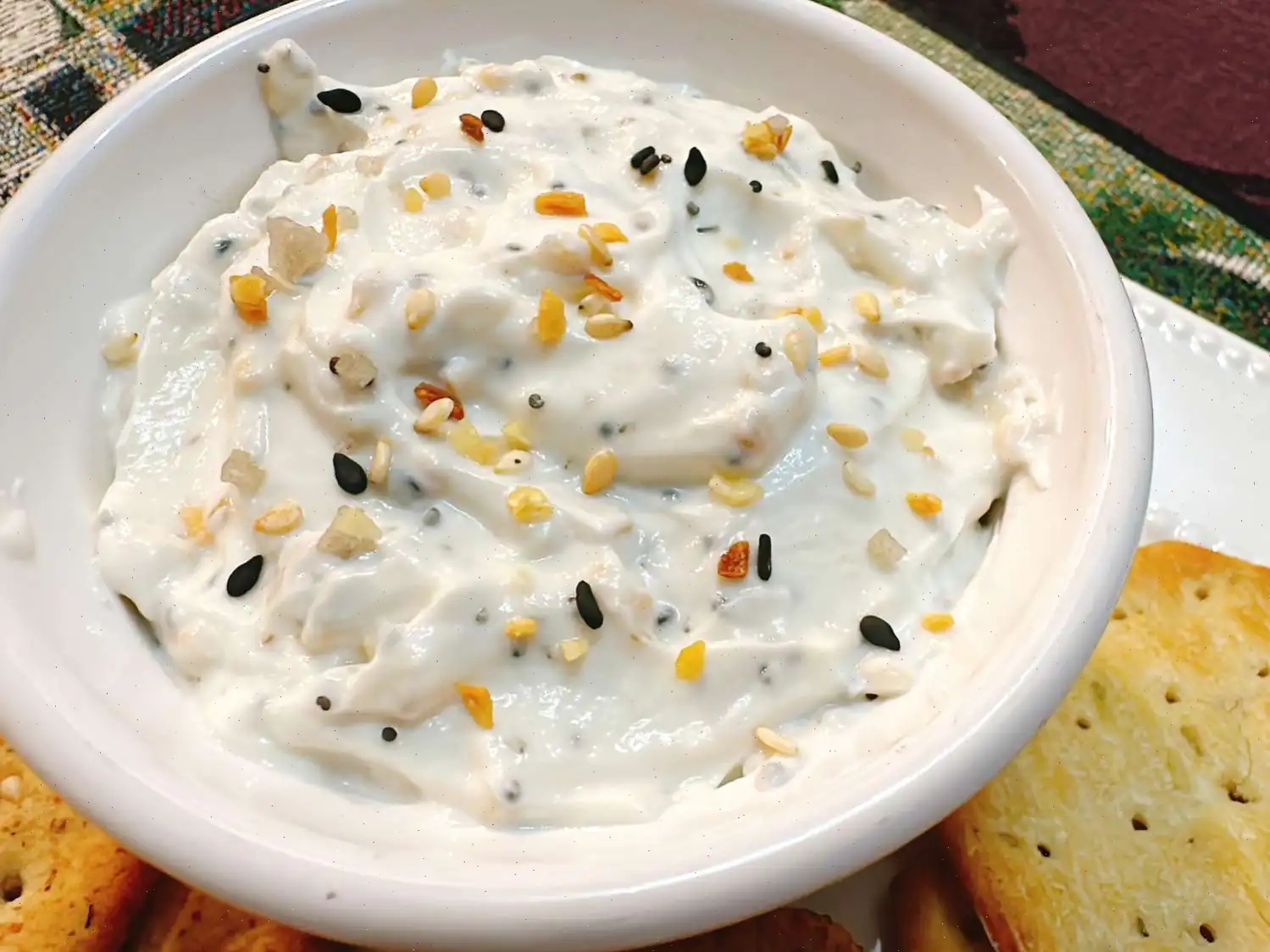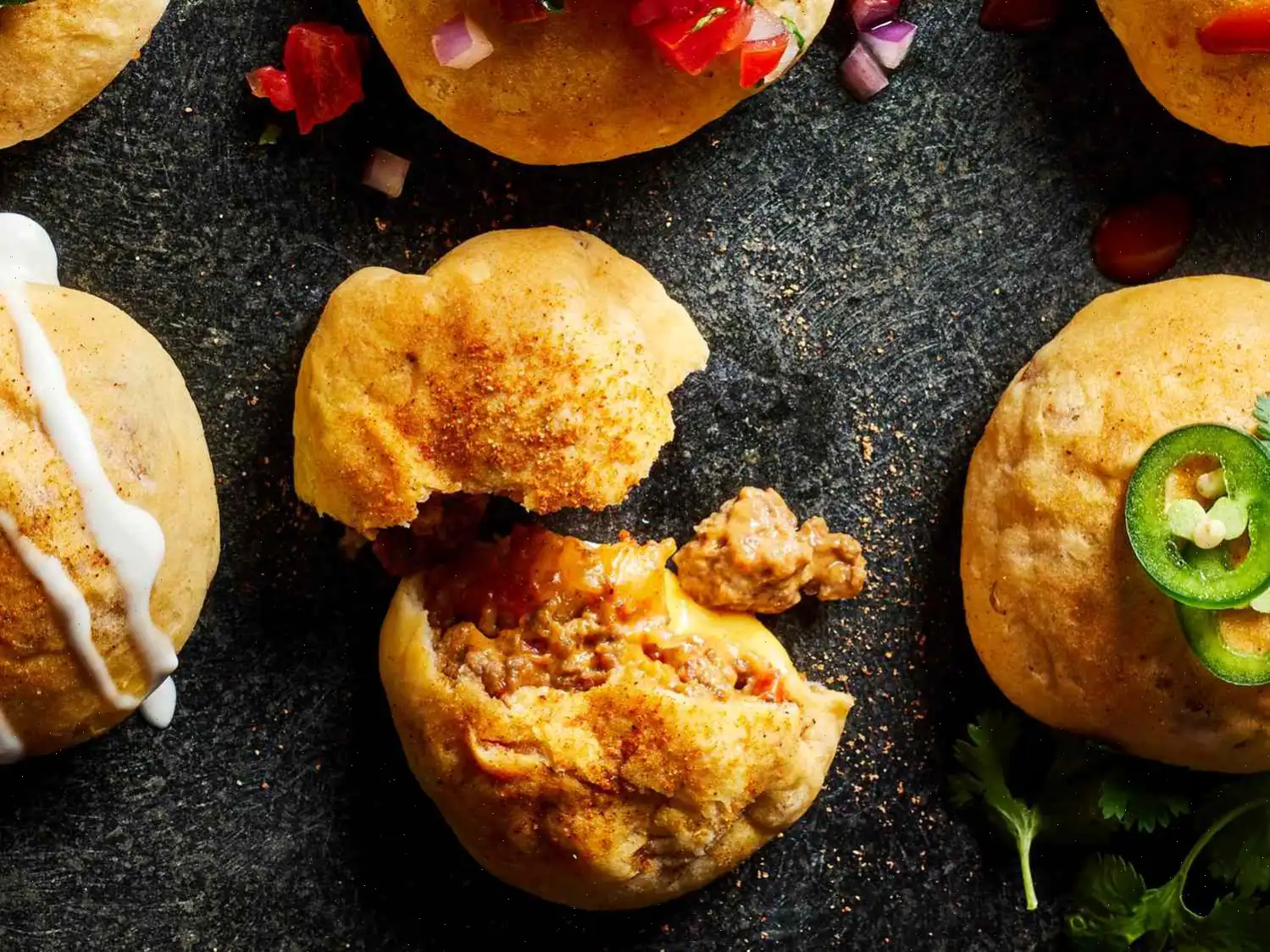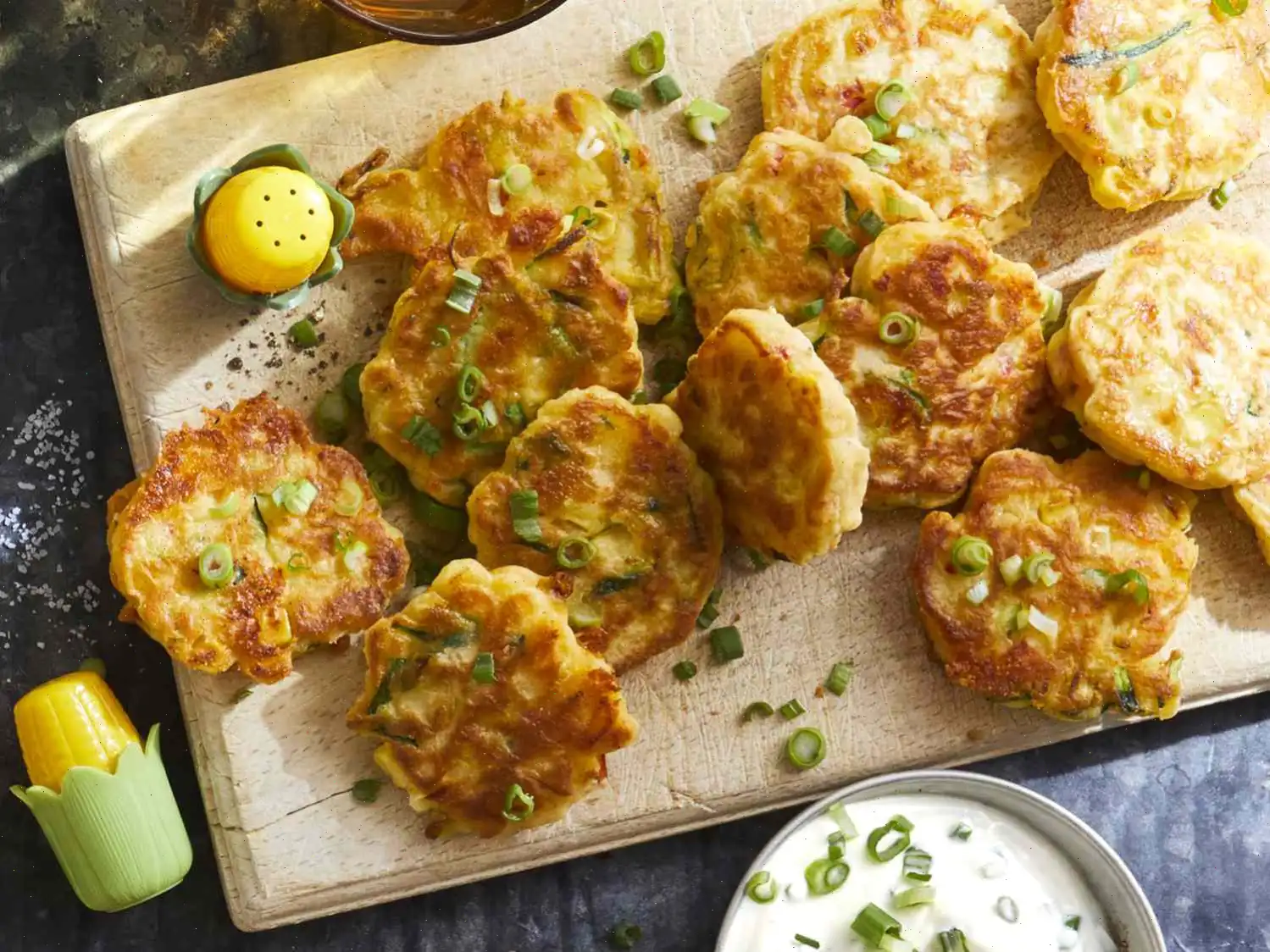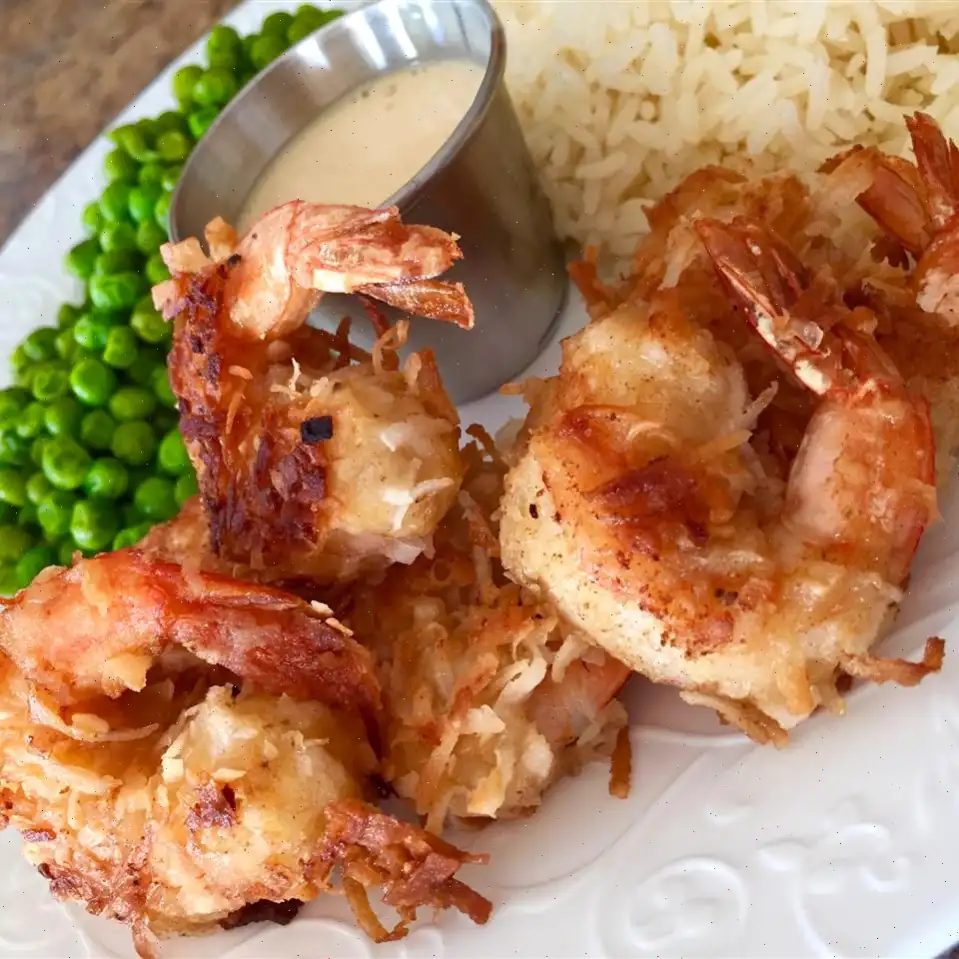
Beef Samosas Recipe
Ingredients:
- 2 large potatoes, peeled
- 1 cup frozen peas, thawed
- 2 tablespoons vegetable oil
- teaspoon cumin seeds
- 1 bay leaf, crushed
- 1 pound ground beef
- 2 large onions, finely chopped
- 4 cloves garlic, crushed
- 1 tablespoon minced fresh ginger root
- 1 teaspoons salt
- 1 teaspoon ground cumin
- 1 teaspoon ground coriander
- 1 teaspoon ground turmeric
- 1 teaspoon chili powder
- teaspoon ground cinnamon
- teaspoon ground cardamom
- teaspoon ground black pepper
- 1 quart oil for deep frying
- 2 tablespoons chopped fresh cilantro
- 2 tablespoons chopped green chile peppers
- 1 (16 ounce) package phyllo dough
Directions:
- Bring a medium saucepan of lightly salted water to a boil. Add the potatoes and peas, cooking until the potatoes are tender but still firm, about 15 minutes. Drain, then mash together and set aside.
- In the meantime, heat 2 tablespoons of oil in a large saucepan over medium-high heat. Add the cumin seeds and bay leaf. Stir until fragrant and the seeds are browned.
- Add the ground beef and onions to the pan, cooking until the beef is browned and crumbly and the onions are soft, around 5 to 7 minutes.
- Stir in the crushed garlic and minced ginger, followed by the salt, cumin, coriander, turmeric, chili powder, cinnamon, cardamom, and black pepper. Continue stirring for another minute to combine the flavors.
- Add the mashed potato and pea mixture to the beef mixture and stir well to combine. Remove from heat and allow the mixture to cool in the refrigerator for 1 hour.
- Once cooled, mix the chopped cilantro and green chile peppers into the potato-beef mixture.
- Heat 1 quart of oil in a deep saucepan over medium heat. Lay a sheet of phyllo dough on a clean surface and place approximately 1 tablespoon of the mixture on the center of the sheet.
- Fold the phyllo dough into a triangle shape, pressing the edges together with moistened fingers to seal the samosa.
- Carefully lower the samosas into the hot oil in batches. Fry until golden brown, about 3 minutes per batch.
- Transfer the fried samosas to a paper towel-lined plate to drain excess oil. Repeat with the remaining samosas.
- Serve the samosas warm, and enjoy!
Nutrition Facts (per serving):
- Calories: 258
- Total Fat: 15g (19% DV)
- Saturated Fat: 4g (20% DV)
- Cholesterol: 21mg (7% DV)
- Sodium: 346mg (15% DV)
- Total Carbohydrate: 24g (9% DV)
- Dietary Fiber: 2g (8% DV)
- Total Sugars: 2g
- Protein: 8g (15% DV)
- Vitamin C: 14mg (16% DV)
- Calcium: 21mg (2% DV)
- Iron: 2mg (11% DV)
- Potassium: 307mg (7% DV)
* Percent Daily Values are based on a 2,000 calorie diet. Your daily values may be higher or lower depending on your calorie needs.
Origin and History
Samosas, originally from the Indian subcontinent, have a fascinating history that dates back over a thousand years. The word "samosa" is derived from the Persian word "sanbosag," which means "triangle-shaped." They are believed to have been introduced to India by traders from Central Asia and Persia. Over time, the recipe was adapted to suit local tastes and ingredients, becoming an iconic dish in Indian cuisine. Today, samosas are enjoyed worldwide, from the streets of India to restaurants in the West.
Regional Variations
While samosas are a beloved snack throughout the Indian subcontinent, there are several regional variations. In North India, samosas are typically filled with spiced potatoes, peas, and sometimes meat, while in the South, they may include coconut and tamarind, creating a distinct flavor profile. In Pakistan and Bangladesh, beef and chicken samosas are common, often spiced with chili and garam masala. The type of pastry also varies, with some regions using a thin, flaky dough, while others prefer a sturdier, more dough-like wrapper. The filling is often a matter of personal preference or local tradition, with variations including lamb, vegetables, or even cheese.
Differences from Similar Dishes
Samosas may be similar to other fried pastries, such as spring rolls or empanadas, but they stand out due to their unique triangular shape and the complex spice mixture in the filling. Unlike empanadas, which tend to have a slightly sweeter filling, samosas are known for their bold, savory flavors. Spring rolls, on the other hand, are often lighter in texture and are usually wrapped in rice paper rather than dough. The spice combination in samosas, which typically includes cumin, coriander, turmeric, and chili powder, gives them a distinctive Indian flavor that sets them apart from other pastry-based snacks.
Where to Find Samosas
Samosas are typically found in a variety of settings. In India, they are commonly sold by street vendors, served as appetizers at family gatherings, or enjoyed during festive occasions. In restaurants, samosas are often found on the appetizer menu, paired with chutneys like mint or tamarind. Outside of India, samosas are a popular dish in Middle Eastern, African, and Southeast Asian cuisines. In Western countries, they have become a staple in Indian restaurants and are often served as a finger food at parties or gatherings. Whether deep-fried or baked, samosas are a favorite choice for anyone seeking a tasty, portable snack.
Fun Facts about Samosas
- Samosas are not only popular in India; they are also widely enjoyed in parts of the Middle East, Africa, and even Central Asia, where they have been adapted to local tastes.
- The triangular shape of the samosa is not just for aesthetics; it symbolizes prosperity and good fortune in many cultures.
- Though the traditional filling is made of potatoes and peas, samosas can also be made with a variety of other fillings, including lentils, cheese, and even fruit.
- Samosas have inspired many modern takes, with fusion versions that include non-traditional fillings like pizza or chocolate.
- In some parts of India, samosas are served with a sweet, tangy chutney, creating a delightful contrast of flavors that complement the savory filling.
You can listen to this recipe in AI audio format. Simply click the play button below to listen to the content in a format that suits you best. It’s a great way to absorb information on the go!
FAQ about Beef Samosas Recipe
Comments
Gary Scott
08/17/2024 05:23:10 PM
I enjoyed the tasty filling in this recipe, but I found the phyllo dough to be lacking in authenticity. I received this recipe from an Indian friend and decided to give it a try. Here are the ingredients and method for the base: Ingredients: - 2 cups of plain flour - 1/4 tsp salt - 4 tbsp of oil or ghee - 4 tbsp of water Method for the base: 1. Mix all the ingredients for the base together with your fingers until it forms a dough. Add a tiny bit more water if needed. 2. Knead the dough for about 10 minutes or until it is smooth. 3. Place the dough in a plastic bag and set aside for 30 minutes or longer, preferably in the refrigerator. To prepare the dish, take a walnut-sized portion of dough, roll it out to about 4 inches across, place a couple of tablespoons of filling in the center, fold the dough over to create a semicircle, press the seams together, roll the edges, and fry until golden. I apologize for the lengthy post, but I hope this detailed explanation is helpful. =)
Matthew Anderson
09/20/2022 03:48:25 AM
Delightful! I prepared this dish with chicken livers, onion, and garlic, lightly brushed with oil and baked on parchment paper. The result was a light and crispy texture. I think it would be even better with the addition of raisins or cranberries.
Ashley Harris
06/03/2024 11:30:54 PM
I have been experimenting with this samosa recipe for over a year and have tried various types of wrappers and cooking methods. After many attempts, I found that using a dough similar to pie crust or pierogi dough works best (avoid phyllo dough as it is too flaky). Deep-frying them yields the best results compared to pan-frying or baking. For the filling, I follow the directions exactly but I don't mash the peas. I also like to add 3 tablespoons of lemon juice and half a tablespoon of green chili chutney for extra flavor. I prepare the filling in advance and refrigerate it until I'm ready to make the samosas. To assemble, I make sure to seal the edges of the dough well with a flour-water mixture to prevent any leaks during cooking. I freeze half of the samosas for later and fry the rest at 180 degrees Celsius for 6 minutes. This method ensures perfect, crispy samosas every time.
Emily Collins
06/29/2023 10:37:34 PM
Substituting ginger powder for ginger root and baking triangle-shaped pastry puffs brushed with egg at 400 degrees until golden brown, then pairing them with a chutney dipping sauce, resulted in an outstanding dish!
Ronald Phillips
10/22/2022 08:22:14 PM
I incorporated feedback from reviewers by making the following changes: I followed the recommendation to use a different type of dough, and I must say it was a significant improvement compared to using phyllo dough! For the dough, I used 2 cups of all-purpose flour, 4 tablespoons of oil, and 4 tablespoons of water. While I needed double the amount of this dough recipe for the filling, the dough turned out great. Instead of peas, I opted for lentils, and I used garam masala in place of cardamom since I didn't have any on hand. These substitutions gave the samosas a very authentic flavor. I'm considering trying to bake some of them next time. I served them with tzatziki sauce, and it was a hit!
Kenneth Clark
12/01/2023 10:50:31 AM
I added mild chili powder, maybe I should have used hot chili instead.
Betty Collins
09/12/2022 07:02:15 PM
The food was heavenly! If you're not in the mood for pizza, try a samosa instead!
Raymond White
10/27/2024 01:27:42 AM
I absolutely adore it.
Debra Evans
04/09/2023 04:22:38 PM
The dish turned out fantastic! I substituted ground chicken for beef as my wife doesn't eat red meat. I also used wonton wraps instead of phyllo pastry. No regrets whatsoever!
Scott Brown
09/09/2022 10:55:31 AM
The samosas tasted amazing, and I opted to bake them instead of frying. However, I encountered an issue - despite following the recipe, I ended up with way too much filling, only using about a third of it. I decided to get creative and will be repurposing the extra filling in a pre-made pie shell for a samosa pie!


